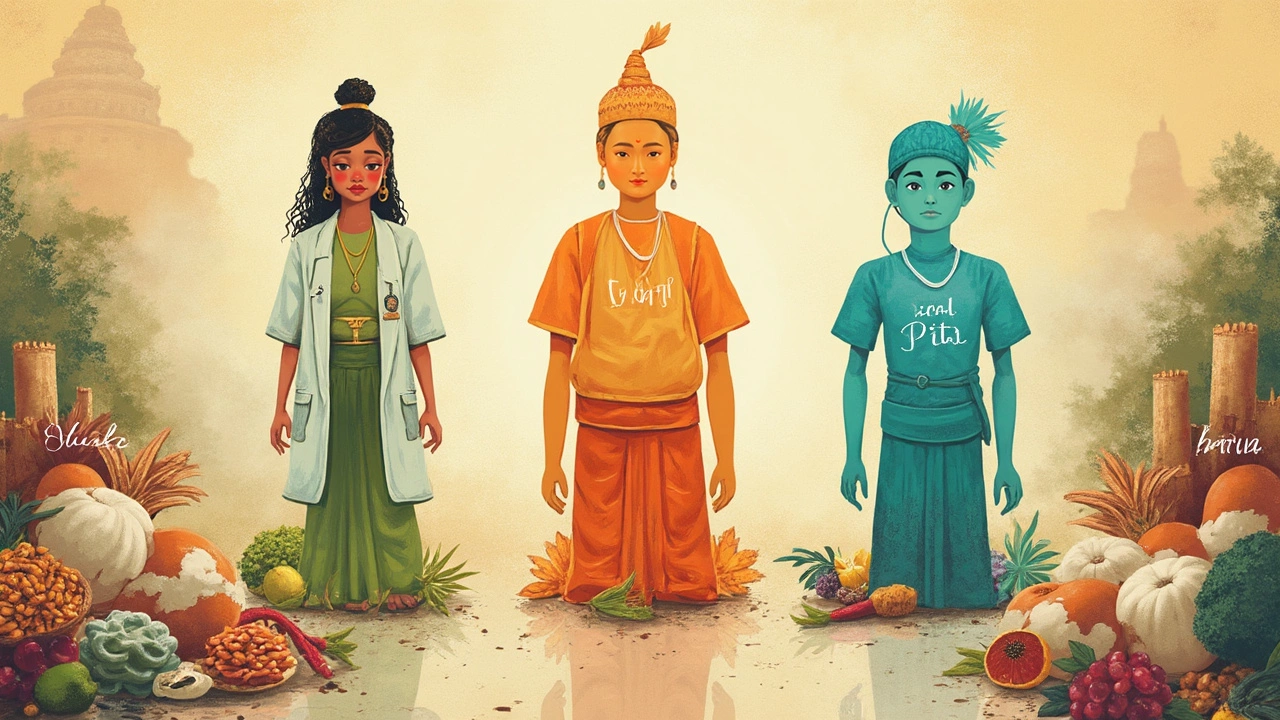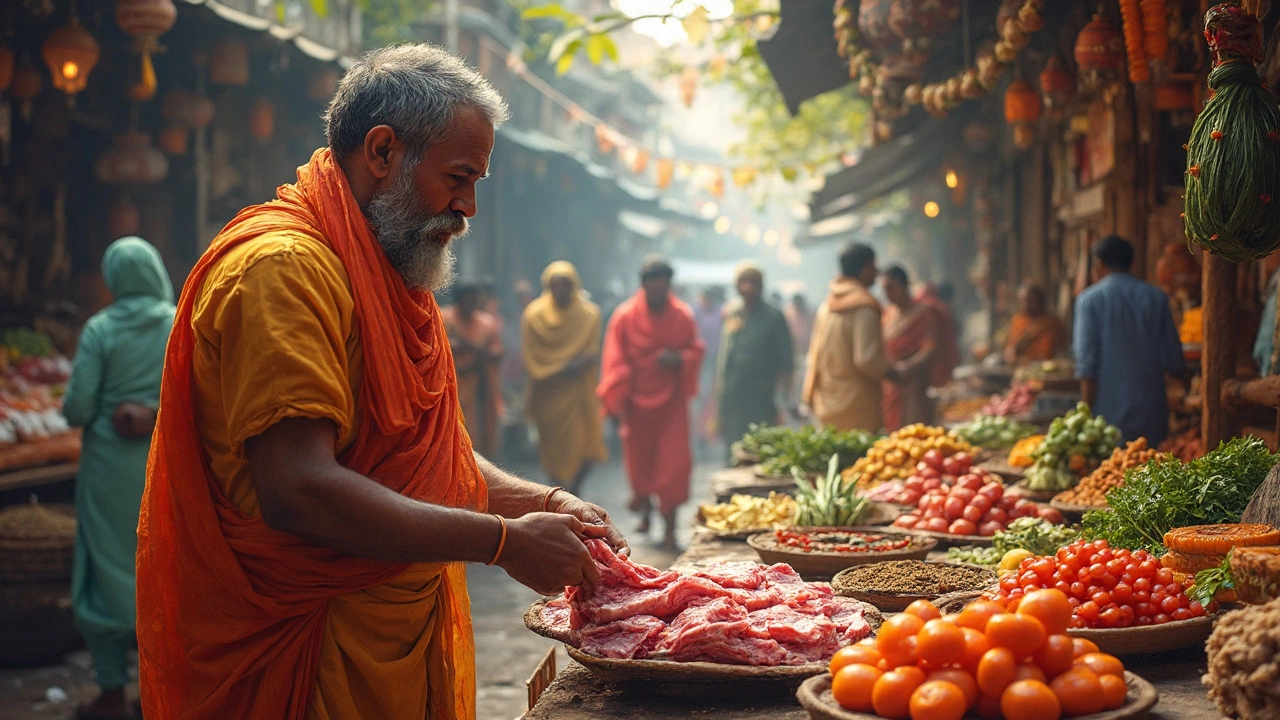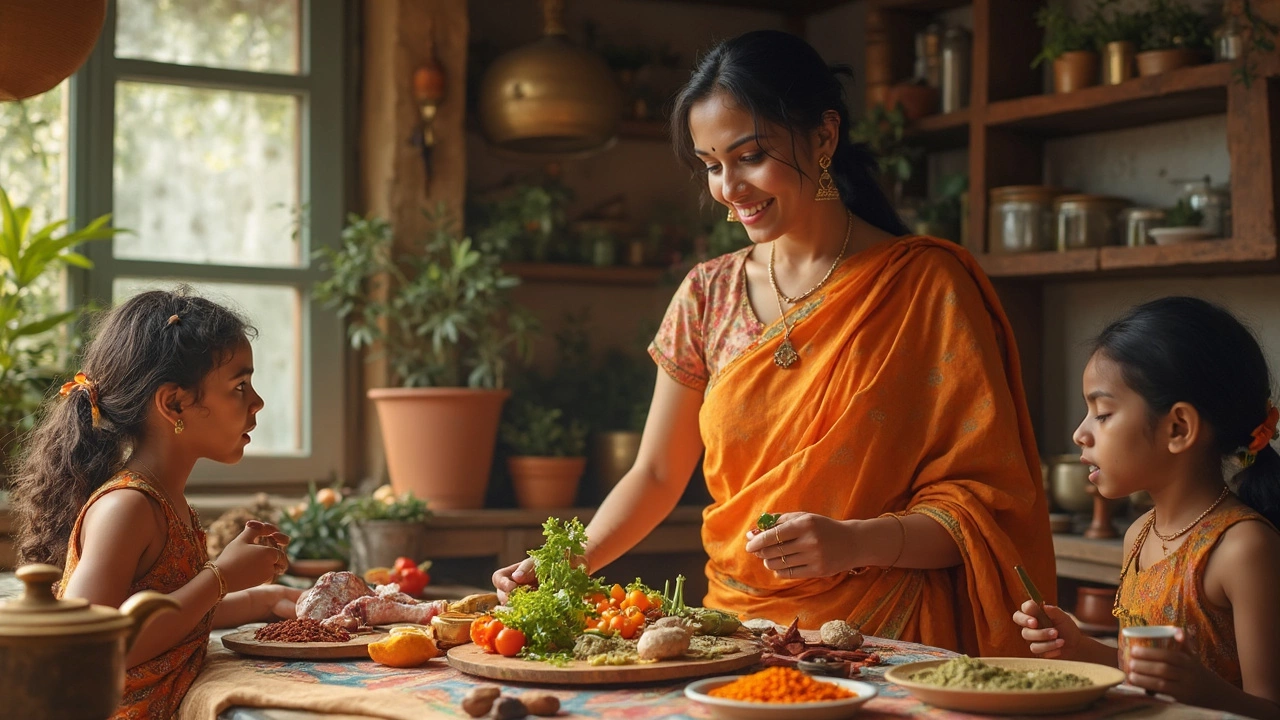Heard that Ayurveda is always vegetarian? Not exactly. If you flip through the old Ayurvedic texts, you'll spot plenty of mentions about eating meat—yes, really. It turns out, Ayurveda isn’t simply about leafy greens and rice; it's about picking foods that suit your body and keep you in balance.
Here’s why this matters: lots of people struggling with tiredness, weak digestion, or recovering from illness get told to eat more protein, but then hear Ayurveda bans meat. That’s not the full story. In fact, those ancient practitioners gave pretty detailed advice about which meats to eat—and when—to help specific people heal or get stronger.
If you’re curious about doing Ayurveda right but don’t want to swear off meat forever, there’s actually a lot you can do. It’s all about listening to your body, knowing what your dosha needs, and understanding how preparation methods matter. Let’s break down the facts, bust some myths, and see how meat may (or may not) fit onto your plate when you follow Ayurvedic wisdom.
- Ayurveda’s Real Take on Meat
- What Classic Texts Actually Say
- Doshas and Animal Foods: Who Should Eat What?
- Modern Ayurvedic Advice (and Some Surprises)
- Tips for Eating Meat the Ayurvedic Way
Ayurveda’s Real Take on Meat
Pretty much everyone thinks Ayurveda means you can only eat plant-based foods, but the real picture is way more flexible. Go back to the classic texts like Charaka Samhita and Sushruta Samhita—they're loaded with references to all kinds of animal foods. Chicken, goat, fish, and even things like rabbit and quail all pop up. Why? Because the old teachers cared about what actually helped a person’s health, not just what fit some dietary label.
Meat in Ayurveda isn’t a black-or-white deal. Instead, they looked at climates, health issues, and body types before recommending it. For example, someone who’s weak from illness, super skinny, or doing heavy physical work might be told to eat meat for strength and energy. There’s also a big difference between who eats meat and how it’s prepared—Ayurveda even lists the qualities of different meats (like heaviness, moisture, or heat) and explains who benefits most.
One table from the Sushruta Samhita explains the effects of various meats on energy and recovery:
| Type of Meat | Main Benefit | Who Should Eat It |
|---|---|---|
| Goat | Strengthens and nourishes | People recovering from illness |
| Chicken | Easy to digest, supports muscle | Elderly or weak digestion |
| Fish | Adds warmth and moisture | Vata people and those in cold climates |
| Quail | Highly nourishing, boosts energy | Those needing rapid recovery |
There’s no blanket rule that says everyone in Ayurveda must avoid meat. But the texts do warn against heavy meats in hot weather, or for people with sluggish digestion (mostly those with a "Kapha" type). There’s also a big point about how and when to eat it–slow cooked, spiced well, never with milk products, and always in moderation.
If you’re exploring Ayurveda for your health, don’t get stuck on labels. The original healers were way more interested in real results than in arguing if you were a vegetarian or not. That mindset makes room for meat—so long as you really need it and prepare it right.
What Classic Texts Actually Say
If you go back to the roots of Ayurveda, the old texts like Charaka Samhita and Sushruta Samhita don’t hide from the meat question. They actually mention meat quite a bit, and not just as a random afterthought. These books give real instructions about what types of meat help with certain health issues—especially when someone needs to build strength fast.
For example, Charaka Samhita lists over 50 types of animal meat, everything from goat and sheep to birds and even fish. The text breaks down which meat is lighter on the stomach, which kind fires up digestion, and what kinds are best when someone is weak or just getting back on their feet after a tough illness. What’s surprising is that the classic texts don’t just focus on what to eat—they spell out how to cook it, like boiling or making soup, to make it easier to digest.
Sushruta Samhita gets even more specific about using meat broths for wounds, surgeries, and recovery. If someone lost blood or was seriously injured, those broths were mainstays in getting them back up and moving. This wasn’t a small detail—meat was seen as a tool in the healing toolbox.
But—and it’s a big but—these texts always tie meat-eating to who should eat it and when. For regular healthy folks, especially those wanting a lighter or spiritual diet, they often recommend a more plant-based approach. But when life throws a curveball—like sickness, heavy labor, or extreme weakness—the advice is crystal clear: meat can have a role.
- Charaka Samhita: Lists different meats and describes their effects on each dosha.
- Sushruta Samhita: Details recipes for meat broths and their healing purposes.
- Ashtanga Hridayam: Advises meat in moderation and mostly for special conditions.
It’s not about blanket bans or all-you-can-eat policy—it’s about picking what supports your body, your lifestyle, and your stage of life. Turns out, Ayurveda always aimed for balance, not rigid rules.

Doshas and Animal Foods: Who Should Eat What?
It’s all about your dosha—the basic body type or energy that Ayurveda says runs your system. You’ve got Vata (airy and dry), Pitta (hot and fiery), and Kapha (cool and heavy). Meat affects each one differently, and the old Ayurvedic texts lay it out pretty direct—no guessing games.
Ayurveda suggests that not all meat is created equal, and not every body type handles animal foods the same way. For example:
- Vata folks usually run cold, get anxious, and can have weak digestion. The classics say moist, rich meats like chicken, duck, and fatty fish help ground and nourish them—especially in winter or after sickness.
- Pitta types burn hotter—hello, heartburn and mood swings. Ayurveda warns them off spicy or overly oily meats like beef or goat. If they do eat meat, lighter options (like chicken or freshwater fish) chilled down with cooling herbs are best.
- Kapha people are sturdy but can get slow and heavy easily. Too much red meat makes them sluggish, so light meats, like rabbit or venison, in small amounts, work better. Lean protein helps keep energy up without adding to the ‘stuck’ feeling Kapha folks sometimes get.
It’s not just opinion—check out this quick reference of what classic texts say about best and worst animal foods for each dosha:
| Dosha | Recommended Meats | Best Avoided |
|---|---|---|
| Vata | Goat, chicken, duck, oily fish | Beef, dry/lean meats |
| Pitta | Chicken, freshwater fish, rabbit | Lamb, beef, spicy/salty meats |
| Kapha | Venison, rabbit, lean poultry | Pork, beef, fatty/oily meats |
But here’s a practical catch: season matters too. If your Kapha feels heavy in spring, lighten up on all meats. If you’re Vata and it’s windy and cold, a hearty meat stew might actually help you feel better.
Want a tip? Never wolf down meat that’s fried or reheated a bunch. Ayurveda says fresh, well-cooked, spiced meat (think black pepper, ginger, cumin) is a lot easier to digest—no matter your dosha. And yes, portion matters. Think small servings, balanced with plenty of veggies and easy-to-digest grains.
Modern Ayurvedic Advice (and Some Surprises)
People tend to think Ayurveda is stuck in the past, but talk to any practicing Ayurvedic doctor today and you’ll see how much things have changed. Most modern Ayurvedic practitioners still favor a vegetarian diet for everyday health, but that’s not the whole story. When it comes to Ayurveda, context really matters. The advice you get depends a lot on your health, your lifestyle, and—even more important—where you live.
If you walk into a modern Ayurvedic clinic in India, you’ll meet folks who grew up seeing goat stew and fish curry right next to lentils and veggies. It’s normal for an Ayurvedic expert to recommend animal foods for people who are recovering from heavy illness, struggle with fatigue, or have certain types of anemia. In fact, the Charaka Samhita (a key old text) listed over 50 kinds of meat used for healing different conditions.
Let’s look at how recommendations really break down these days:
- Chronic illness, post-surgery, or very weak people may get meat broths or stews because they’re easier to digest and give quick strength.
- People with a strong Pitta or Kapha dosha usually get told to limit heavy meats because these can make things worse (think sluggishness, heaviness, or skin flare-ups).
- Vegetarian diets are often advised for people with sensitive digestions or spiritual goals, especially monks, yogis, or those doing lots of meditation.
If you live outside India or in a place where meat is a big part of the local culture, many Ayurvedic counselors will work with what’s around you. No one’s pushing you to suddenly stop all animal foods if that doesn't fit your life or health needs. What matters more is cooking style, portion size, and making sure you don't go overboard.
Sneaky fact most people miss: a 2022 survey of Indian Ayurvedic doctors found about 28% recommend meat at least sometimes, mostly during recovery (see table below). And in the US, around 15% of Ayurvedic practitioners say they occasionally suggest animal protein to clients who ask for balanced, doable advice.
| Region | % Practitioners Recommending Meat | Typical Reasons |
|---|---|---|
| India | 28% | Recovery from illness, anemia, building strength |
| US | 15% | Client cultural preferences, protein needs |
Another twist—Ayurveda isn’t just about the ingredient, but how you use it. Slow-cooked meat with warming spices, paired with easy-to-digest veggies, is preferred over fried or leftover meat. Most experts agree: don’t mix lots of dairy or yogurt with meat, since that can slow down digestion.
The modern takeaway? You don’t have to follow a one-size-fits-all rule. Whether or not you eat meat in Ayurveda, it’s all about balance, your body type, and what makes you feel genuinely healthy.

Tips for Eating Meat the Ayurvedic Way
If you want to fit meat into your Ayurvedic diet, you’ve got to pick your foods carefully. Ayurveda doesn’t just look at the food itself, but also at how and when you eat it. Here’s how you can make meat work for you, without throwing your system out of whack.
- Know Your Dosha: Different doshas react to meat in different ways. Vata types may need heavier, moist meats like chicken or fish for grounding. Pittas are better off with cooling, lean meats (think turkey or freshwater fish). Kaphas should only eat small amounts since heavy meats can make them sluggish.
- Keep It Fresh and Local: Ayurveda says fresh, locally sourced meat supports digestion best. Avoid processed or old meat, which can create toxins (ama) and digestive problems.
- Spice It Up: Cooking with spices isn’t just about taste. Black pepper, ginger, cumin, and turmeric actually help your body digest meat. They reduce heaviness and cut down the chance for bloating or gas.
- Watch the Portion: Ayurveda recommends eating meat in moderation—about 1-2 times a week for most people. Eating too much, especially at dinner, makes your body work overtime and can throw your balance off.
- Cook Meat Well: Avoid undercooked or raw meat. Ayurveda always prefers meat thoroughly cooked with water (like stews or soups) because it’s gentler on your gut.
| Dosha Type | Suggested Meats | Prep Tips |
|---|---|---|
| Vata | Chicken, fish, lamb | Cook in oily stews, add warming spices |
| Pitta | Turkey, rabbit, freshwater fish | Use cooling herbs (cilantro, mint), avoid too much spice |
| Kapha | Quail, venison (small amounts) | Grill or roast, add lots of digestive spices |
One more thing—Ayurveda says never eat meat with dairy, melon, or fruit. Weird combos like that can mess up your digestion big time. Plus, don’t eat meat when you’re stressed or right before bed. Your digestion slows down at night, which can make you feel heavy and tired in the morning.
Choosing meat for an Ayurveda-friendly meal is about making small, smart changes. Follow these tips and you can enjoy the protein while keeping your body in balance.
